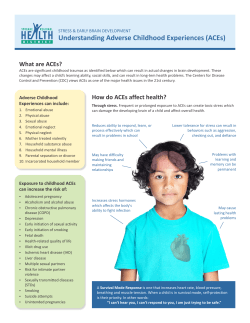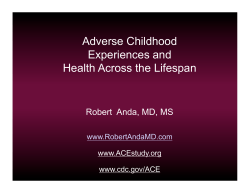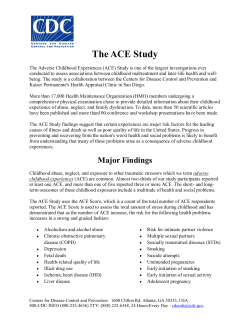
The Role of Adverse Childhood Experiences in Substance Abuse and... Behavioral Health Problems
The Role of Adverse Childhood Experiences in Substance Abuse and Related Behavioral Health Problems “ACEs have created a chronic public health disaster” - Robert Anda, M.D., M.S., Co-Principal Investigator, Adverse Childhood Experiences Study, Centers for Disease Control and Prevention What are Adverse Childhood Experiences? Adverse childhood experiences (ACEs) are stressful or traumatic experiences, including abuse, neglect and a range of household dysfunction such as witnessing domestic violence, or growing up with substance abuse, mental illness, parental discord, or crime in the home. ACEs are strongly related to development and prevalence of a wide range of health problems, including substance abuse, throughout the lifespan. When children are exposed to chronic stressful events, neurodevelopment can be disrupted. Disruption in early development of the nervous system may impede a child’s ability to cope with negative or disruptive emotions and contribute to emotional and cognitive impairment. Over time, and often during adolescence, the child adopts coping mechanisms, such as substance use. Eventually, this contributes to disease, disability and social problems, as well as premature mortality. Figure 1. depicts the lifespan impact of ACEs. Figure 1. Lifespan Impact of ACEs The Adverse Childhood Experiences Study Over the past 15 years, many studies have examined the relationship between ACEs and a variety of known risk factors for disease, disability, and early mortality. The original ACE study began in 1995 and was conducted by the Centers for Disease Control and Prevention (CDC), in collaboration with the health maintenance organization Kaiser Permanente.*i More than 17,000 Kaiser patients completed a confidential survey containing questions about childhood maltreatment and family dysfunction, as well as items detailing their current health status and behaviors. (Felitti et al, 1998). Participants were mostly middle class, white adults with health insurance. Here’s what the study revealed: ACEs are common. For example, 28% of Kaiser participants reported physical abuse and 21% reported sexual abuse. Substance abuse and mental illness of a parent and divorce or separation were also common events. ACEs cluster. Almost 40% of the Kaiser sample reported two or more ACEs and 12.5% experienced four or more. Because ACES cluster, many subsequent studies now look at the cumulative effects of ACES rather than the individual effects of each. ACEs have a dose-response relationship with many health problems. Participants in the ACE Study were followed over time. Findings demonstrated that a person’s cumulative ACE score has a strong, graded relationship to numerous health, social, and behavioral problems throughout their lifespan, including substance use and abuse. Also, many ACE-related problems tend to be co-morbid or co-occurring. Since the launch of the initial ACE Study, numerous other studies with different populations have been conducted with similar results. The Relationship of ACEs to Substance Use and Related Behavioral Health Problems Research has demonstrated a strong graded (i.e., dose-response) relationship between ACEs and a variety of substance use-related behaviors, including: Early initiation of alcohol use. For states, tribes, and jurisdictions focusing on underage drinking, these results suggest the importance of addressing ACEs as one component of preventing underage drinking, as responses to underage drinking may not be effective unless they help youth recognize and cope with stressors of abuse, domestic violence and other adverse experiences (Dube et al, 2006) Problem drinking behavior into adulthood (Dube et al, 2002) Increased likelihood of early smoking initiation (Anda et al, 1999)) Continued smoking, heavy smoking during adulthood (Ford et al, 2011) Prescription drug use (Anda et al, 2008) Lifetime illicit drug use, ever having a drug problem, and self-reported addiction (Dube et al, 2003) Research has also demonstrated a strong graded relationship between ACEs and related behavioral problems, such as the following: Increased risk of suicide attempts, including attempts by men and women, as well as attempts during adolescence and adulthood (Dube et al, 2004). Lifetime depressive episodes (Chapman et al, 2004). Sleep disturbances in adults (Chapman et al, 2011) Sexual risk behaviors (Hillis et al, 2001) Teen pregnancy (Hillis et al, 2004) Incorporating ACEs into Substance Abuse Prevention Efforts Because ACEs are common and strongly related to a variety of substance abuse and related behavioral health outcomes, prevention of ACES and early identification of those who experience ACEs could prevent a number of negative consequences and have a significant impact on a range of critical health problems. Specifically, practitioners can thus strengthen their substance abuse prevention efforts by: Collecting state- and county-level ACE data to drive local decision making (e.g., by incorporating ACEs s indicators into Behavioral Risk Factors Surveillance Systems) Increasing awareness of ACEs among state- and community-level substance abuse prevention practitioners, emphasizing the relevance of ACEs to multiple behavioral health disciplines Including ACEs among the primary risk and protective factors considered when engaging in substance abuse prevention planning efforts Selecting and implementing programs, policies, and strategies designed to address ACEs; including efforts focusing on reducing intergenerational transmission of ACEs Using ACEs research and local ACEs data to identify groups of people who may be at higher risk for substance abuse and related behavioral health problems References Anda RF, Croft JB, Felitti VJ, Nordenberg D, Giles WH, Williamson DF, Giovino GA. Adverse childhood experiences and smoking during adolescence and adulthood . Journal of the American Medical Association 1999; 282: 1652–1658. Anda RF, Brown DW, Felitti VJ, Dube SR, Giles WH. Adverse childhood experiences and prescription drug use in a cohort study of adult HMO patients . BMC Public Health 2008; 4;8:198. Chapman DP, Anda RF, Felitti VJ, Dube SR, Edwards VJ, Whitfield CL. Adverse childhood experiences and the risk of depressive disorders in adulthood . Journal of Affective Disorders 2004; 82:217–225. Chapman DP, Wheaton AG, Anda RF, Croft JB, Edwards VJ, Liu Y, Sturgis SL, Perry GS. Adverse childhood experiences and sleep disturbances in adults. Sleep med 2011; 12: 773-79. Dube SR, Anda RF, Felitti VJ, Chapman D, Williamson DF, Giles WH. Childhood abuse, household dysfunction and the risk of attempted suicide throughout the life span: Findings from Adverse Childhood Experiences Study . JAMA 2001; 286: 3089–3096. Dube SR, Anda RF, Felitti VJ, Edwards VJ, Croft JB. Adverse Childhood Experiences and personal alcohol abuse as an adult . Addictive Behaviors 2002; 27(5):713–725. Dube SR, Miller JW, Brown DW, Giles WH, Felitti VJ, Dong M, Anda RF. Adverse childhood experiences and the association with ever using alcohol and initiating alcohol use during adolescence . Journal of Adolescent Health 2006; 38(4): 444.e1-444.e10. Felitti VJ, Anda RF, Nordenberg D, Williamson DF, Spitz AM, Edwards V, Koss MP, Marks JS. Relationship of childhood abuse and household dysfunction to many of the leading causes of death in adults: the adverse childhood experiences (ACE) study . American Journal of Preventive Medicine 1998; 14:245– 258 Ford ES, Anda RF, Edwards VJ, Perry GS, Zhao G, Tsai J, Li C, Croft JB. Adverse childhood experiences and smoking status in five states. Prev Med 2011;53: 188-93. Hillis SD, Anda RF, Felitti VJ, Marchbanks PA. Adverse childhood experiences and sexual risk behaviors in women: a retrospective cohort study . Family Planning Perspectives 2001;33:206–211 Hillis SD, Anda RF, Dube SR, Felitti VJ, Marchbanks PA, Marks JS. The association between adverse childhood experiences and adolescent pregnancy, long-term psychosocial outcomes, and fetal death . Pediatrics 2004; 113(2):320–327. i For more information on this study, visit the Adverse Childhood Experiences Survey web page at http://www.cdc.gov/ace/index.htm
© Copyright 2025





















